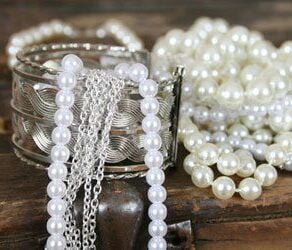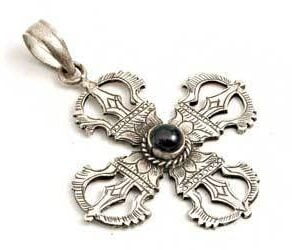
Whether in the form of jewelry, cutlery or dishware, silver adds a touch of elegance. Over time, it also develops a dull gray or black coating called tarnish. Tarnish is caused by a chemical reaction between the silver and sulfur and can ruin the beauty of your silver. There are two basic methods to remove tarnish from silver and if used regularly, either one will keep your silver looking its best.
General Cleaning
If the item is not tarnished, just a little dusty or has some makeup smudges or fingerprints that need to be removed, a general cleaning will suffice.
You Will Need:
- A paintbrush
- A bowl
- Dish liquid
- A towel
- A soft cloth
Steps:
- Begin by brushing away any dirt that is on the surface or ingrained in the detailing using a soft paintbrush.
- Fill a bowl or bucket with warm water and a small amount of mild (bleach-free) dish liquid.
- Put the silver piece in the soapy water and gently rub it with your hand to wash it clean.
- Rinse the item with plain water.
- Dry the silver with a soft towel.
- Gently buff the surface with a soft dry cloth to bring out the shine.
How to Polish Silver Clean
Cleaning off tarnish with a silver polish is the most common method of cleaning silver. If you decide to use silver polish, ALWAYS read and follow directions carefully as some types of polish are toxic in nature and can be harmful if not handled correctly. Many companies offer non-toxic alternatives to traditional silver polish that can be used instead.
You Will Need:
- Dish soap
- Warm water
- Large Bowl
- Sponge
- Clean, absorbent towel
- Two polishing cloths
- Silver polish*
*Silver polish can be purchased at most department stores or jewelry stores, or online.
The Cleaning Process:
- Fill your bowl with warm water, adding a few drops of liquid dish soap.
- Add your silver item(s) to the sudsy water and wash thoroughly with the sponge.
- Rinse your item in clean, warm water, and dry thoroughly using the absorbent towel.
- Place a small amount of polish on one polishing cloth and rub onto the item thoroughly as per the directions on the polish (there are many different types of polish available for silver and each one may have different directions for use. Make sure you follow the directions on your particular polish).
- With the clean polishing cloth, remove the polish from the item using a brisk, buffing motion (again, always follow the specific directions for your particular polish).
- There is usually no need to rinse your items once the polishing is done (unless otherwise directed by the product directions for the polish you are using), and your item should be tarnish-free. If not, you may want to repeat the procedure.
How to Boil Silver Clean
There is another non-toxic method for cleaning silver that can be accomplished with items you likely already own. As long as the item is small enough to fit in a pan, the method below can be used to remove tarnish from it.
You Will Need:
- Dish soap
- Water
- Large bowl
- Sponge
- Clean, absorbent towel
- Cooking pot (size depends on the size and number of silver items you need to clean)
- Aluminum foil
- Polishing cloth
- Baking soda
The Cleaning Process:
- Fill your bowl with warm water, adding a few drops of liquid dish soap.
- Add your silver item(s) to the sudsy water and wash thoroughly with the sponge.
- Rinse your item in clean, warm water, and dry it thoroughly using the absorbent towel.
- Line your cooking pan with aluminum foil.
- Add enough water to completely cover the tarnished item(s). (DO NOT add items yet!)
- Stir in a couple of tablespoons of baking soda for small items in a small pan, or as much as a cup or two for large items in a gallon or more of water.
- Turn the burner on underneath the pan and bring the water/baking soda solution to a boil, allowing it to boil until all the baking soda is dissolved. Make sure the baking soda is dissolved before adding your items, as the baking soda may be too abrasive for some silver items.
- Once the water is boiling, place tarnished item(s) into the boiling water, making sure they are in contact with the aluminum foil, and remove the pot from the heat.
- Allow the item(s) to soak in the pot for several minutes (at least 10), stirring occasionally and gently. The hot solution of baking soda and water will separate the sulfur from the silver, transferring it to the aluminum. You will see black or gray flakes in the water, and the aluminum will start to turn black.
- After several minutes, when the tarnish has faded, remove the item, and buff it dry with a clean towel (be aware that some additional tarnish may come off onto the towel).
- For heavily tarnished items, it may be necessary to repeat steps 4 through 10.
Additional Tips and Advice
- Contact with the oils from your skin helps prevent tarnish from forming, so handle your silver items and wear your silver jewelry regularly.
- Keep your silver away from materials such as felt, wool, and rubber (including the rubber drying mats often used for dishes) as these materials tend to accelerate the formation of tarnish.
- Avoid exposing silver to foods such as mayonnaise, eggs and mustard, as these foods are high in sulfur content and will hasten the buildup of tarnish.
- When choosing a silver polish, choose polishes that are non-abrasive, such as Tarni-Shield, Twinkle and Blitz and opt for gels and liquid instead of sprays.
- Never use another metal polish, such as brass cleaner, on silver.
- If cleaning an item that is silver-plated, be very gentle in cleaning since the silver plating can be easily scratched or damaged.
- If, after attempting to remove tarnish from silver (not silver-plated) items, a purplish stain remains, it may not be tarnish, but a “fire stain” found on many early silver pieces. Continued attempts at removal may damage your piece. When in doubt, contact a professional silversmith or company specialized in silver restoration.
- If you are going to store silver for an extended period of time, consider using a tarnish-retardant prior to storing. Many polishes have tarnish-retardant properties built in. Make sure to check the label.
- Silver dinnerware, including sterling silver and plated silver, can be cleaning in the dishwasher as long as only a small amount of gentle detergent is used and they are not touching any other metal items in the wash as well. (Stainless steel and some other metals will react with silver, leaving a mark or pitting on both pieces.) Stop the dishwasher when it reaches the dry cycle and dry the silver items by hand with a soft cloth.
- If you are ever in doubt about the cleaning or restoration of your fine silver, don’t hesitate to contact a silversmith or silver restoration company. Most are more than happy to advise you as to the best way to protect and preserve your fine silver. For more information, or to find a silversmith in your area, visit the website for The Society of American Silversmiths.
Sources:
- Jewelry Fix-ups by David McLoughlin
- Martha Stewart’s Homekeeping Handbook by Martha Stewart
- Home Comforts; The Art & Science of Keeping House by Cheryl Mendelson
- Household Hints for Dummies by Janet Sobesky







This may sound silly, but there is a simpler way to clean silver. We tried this with my brother’s necklace. It was darkening and so we put it in a bowl of soy sauce and left it there for a couple of days. Took it out and it was clean silver!
Toothpaste is a gem for cleaning silver!
Toothpaste is okay, but it scratches the silver; not my favorite. I like to buy the solution sold at department stores; it’s safe and quick.
I have some braclets of the silver electroform process that are getting black tarnish spots. Tried rubbing with a soft cloth–no good. So how do I clean them?
Becky,
Use the method for boiling silver clean; that will remove the tarnish. It would be better not use silver polish since they are bracelets and will be worn against the skin (many of the polishes should not be touched). Good luck!